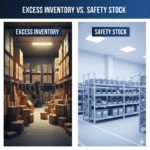In today’s fast-paced business environment, having excess inventory is a common challenge for many companies. Whether due to overestimating demand, slow sales, or unexpected changes in the market, excess inventory can tie up valuable resources, space, and cash. However, there is a powerful solution: liquidation.
In this post, we’ll explore why businesses should consider liquidating excess inventory, highlighting its multiple benefits such as improving cash flow, optimizing space, reducing risk, and positioning your business for future growth.
What is Excess Inventory and Why Does it Happen?
Excess inventory refers to stock that is over and above what is necessary to meet current demand. This situation can occur for various reasons, including:
- Over-forecasting: Predicting higher demand than what materializes.
- Supply Chain Disruptions: Delays, shortages, or other supply chain inefficiencies that lead to inventory pile-ups.
- Obsolescence: Products losing relevance or becoming outdated.
- Seasonality: Holding onto seasonal goods past their peak demand.
While holding inventory can provide a cushion during unforeseen events, when it becomes excessive, it can drain resources. Here’s where liquidation steps in as a practical and strategic solution.
Why Liquidate Excess Inventory?
Liquidation isn’t about giving up — it’s about maximizing the potential of assets that are currently underperforming. Here are the key benefits of liquidating excess inventory:
1. Improve Cash Flow
One of the biggest advantages of liquidating excess inventory is the immediate boost to cash flow. When inventory is tied up in stock, it’s essentially money that you can’t use for other critical business needs such as marketing, R&D, or paying suppliers. By liquidating unsold stock, you can unlock cash that can be reinvested to generate new growth.
This process helps in converting idle goods into liquid capital, allowing for more agile decision-making and faster responses to market opportunities.
2. Free Up Valuable Space
Storing excess inventory comes with significant costs, from warehouse fees to increased handling. Not only does excess inventory take up precious storage space, but it also limits your ability to bring in new stock that might be more in demand. Liquidating surplus goods allows you to free up space for new products, seasonal stock, or even innovative product lines, keeping your business nimble and adaptable.
3. Mitigate Risk of Product Obsolescence
Over time, unsold inventory can depreciate in value, especially in industries like fashion, technology, and perishables. Liquidating excess stock before it becomes obsolete allows you to recover more value. For instance, technology products can lose up to 30% of their value each year, while seasonal goods can go unsold if not moved quickly.
By acting before these items lose their value, you prevent long-term losses, preserve margins, and avoid having to deal with unsellable products down the line.
4. Reduce Holding Costs
Excess inventory often comes with hidden costs, including storage, insurance, and energy for managing goods. These holding costs can quickly add up, eating into your bottom line. Liquidation helps eliminate these ongoing expenses by clearing out products that are not selling, allowing you to focus your resources on more profitable areas of your business.
5. Enhance Brand Reputation
When done correctly, liquidation can enhance your business’s reputation by preventing stock from languishing in warehouses and creating a negative image of your brand. For example, selling old stock at a discounted rate through reputable liquidation channels allows you to maintain your brand integrity, clear out space, and introduce new, higher-quality products to the market.
6. Environmental & Social Responsibility
Liquidation doesn’t necessarily mean dumping products or contributing to landfill waste. By donating unsellable goods or offering them to non-profits, businesses can enhance their Corporate Social Responsibility (CSR) efforts. This not only helps the environment but can also create positive public relations by showing your commitment to sustainability.
When to Liquidate Inventory?
Knowing when to liquidate is key to maximizing your return. Here are some common signs it’s time to act:
- Excess Inventory is Growing: If your stockpile is increasing and taking up more space than it should, it’s time to act.
- Seasonal Stock Has Passed Its Peak: After the season ends, products may start to lose relevance. Liquidating them early can prevent markdowns or total write-offs.
- Low Turnover Rates: If your products are staying on shelves longer than anticipated, it’s a sign you may be overstocked.
- Upcoming Product Launches: If new products are about to launch and you need room, liquidation can help make space for fresh stock.
Acting sooner rather than later ensures you avoid deeper discounts, decreased margins, and lost opportunities.
How Liquidation Can Benefit Your Business Strategy?
While liquidation might sound like a last-resort move, it’s actually a strategic decision that can support long-term business growth. Here’s how:
- Cash for New Opportunities: With more cash on hand, you can reinvest in higher-performing products or invest in growth initiatives.
- Reputation for Adaptability: Businesses that are agile enough to liquidate slow-moving products quickly tend to be perceived as adaptive and responsive to market trends.
- Risk Diversification: By clearing out risky inventory, you make your business more resilient to market volatility and changing consumer behavior.
Best Practices for Liquidating Excess Inventory
If you decide to liquidate, here are a few tips for doing it efficiently:
- Partner with a Reputable Liquidator: A professional liquidator can help you find the right buyers and negotiate favorable terms.
- Choose the Right Channel: Whether through bulk sales, online marketplaces, or liquidation events, pick the right approach based on your product type and target audience.
- Maintain Transparency: Be clear with your customers, stakeholders, and employees about why liquidation is happening and how it aligns with your business strategy.
Why Choose LiquidateProducts?
At LiquidateProducts, we specialize in helping businesses like yours recover maximum value from excess inventory. Our team has years of experience navigating the complexities of liquidation, offering you expert guidance to ensure a smooth and profitable process. Whether you need to move excess stock quickly or plan a long-term liquidation strategy, we have the tools, connections, and expertise to help you succeed.
Ready to Clear Out Your Excess Inventory?
Don’t let excess inventory hold your business back. Contact LiquidateProducts today to learn how we can help you liquidate surplus stock, optimize your space, and improve your cash flow — all while maintaining brand integrity and boosting your bottom line.







